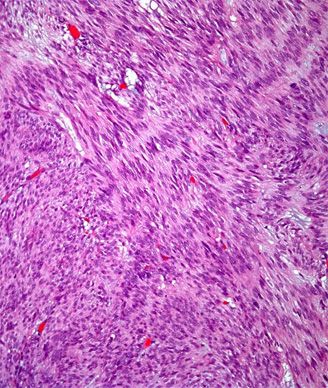Diagnosis of Gastric GIST with Synchronous Gastric Cancer Often Missed
The preoperative diagnosis of combined gastric gastrointestinal stromal tumor (GIST) and gastric cancer is often missed, according to the results of a recent study.
Gastric GIST showing a prominent spindle cell proliferation.

The preoperative diagnosis of combined gastric gastrointestinal stromal tumor (GIST) and gastric cancer is often missed, according to the results of a recent study. However, the research also showed that a patient’s survival often depended on the treatment of the gastric cancer, indicating that active treatment of the gastric cancer could improve patient outcomes.
GIST has a relatively low incidence, but in many cases patients with GIST also present with other synchronous malignancies.
“Since the first report of synchronous epithelial and stromal tumors in the stomach in 2000, many patients with gastric GIST and synchronous gastric cancer have been described, most in single case studies,” wrote Mi Lin, MD, of Fujian Medical University Union Hospital, China, and colleagues. “However, little is known about the synchronous GIST and gastric cancer.”
In an attempt to identify characteristics and prognostic factors, Lin and colleagues conducted a retrospective study of 170 patients with gastric GIST who had undergone surgical resection of their disease between 2000 and 2011. The results were published in the World Journal of Surgical Oncology.
The 42 patients who had synchronous gastric cancer (24.7%) were classified as the CA Group; the 128 patients who did not were the non-CA Group. Patients in the CA Group were more likely to present with symptoms compared with patients in the non-CA Group (P < .05). The most commonly occurring symptoms included abdominal tenderness, black stool, abdominal distension and weight loss. The rate of preoperative diagnosis was 2.4% in the CA group compared with 97.6% in the non-CA group.
“In patients with simultaneous gastric cancer and gastric GIST, the symptoms of gastric GIST were often masked by the clinical symptoms of gastric cancer,” the researchers wrote. In many cases, the GISTs were small and were submucosal, muscular, or subserosal making them difficult to diagnosis.
The 3-year survival was 87% for the whole cohort; the 5-year survival was 82.3%. Patients in the CA group had a 3-year survival of 62.6% and a 5-year survival of 57.8%. In contrast, patients in the non-CA group had a 3-year survival of 94.8% and a 5-year survival of 90.1%, a statistically significant difference from that seen in the CA group.
Looking at patient characteristics, the researchers found that patient age, risk stratification, postoperative oral imatinib, and synchronous gastric cancer were all predictive of survival (P < .05 for all).
“The 5-year survival rates were significantly lower among patients with synchronous gastric cancer, both among patients stratified as being at very low risk and among those stratified as being at intermediate risk/high risk,” the researchers wrote.
Newsletter
Stay up to date on recent advances in the multidisciplinary approach to cancer.